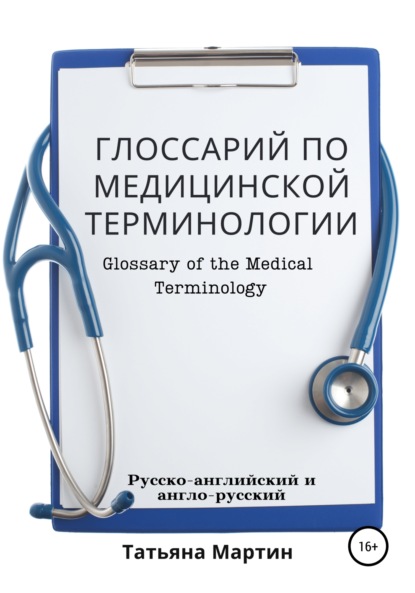По всем вопросам обращайтесь на: info@litportal.ru
(©) 2003-2025.
✖
Глоссарий по медицинской терминологии, русско-английский
Настройки чтения
Размер шрифта
Высота строк
Поля
Глоссарий по медицинской терминологии. Glossary of the Medical Terminology
Татьяна Мартин
В представляемом глоссарии по медицинской терминологии приводятся эти термины на двух языках: русском и английском и подается их краткое описание. В глоссарии термины подаются в соответствии с органами и системами человеческого организма, их патологии, диагностики и лечения. Глоссарий будет полезен для медицинских работников, людей, занимающихся переводами медицинской литературы и для широкой публики.
Татьяна Мартин
Глоссарий по медицинской терминологии. Glossary of the Medical Terminology
Section 1: Системы Тела Человека; Human Body System
В теле человека различают системы: кожную, костную, мышечную, пищеварительную, дыхательную, мочеполовую, сердечно-сосудистую, нервную, органы чувств, и систему желез внутренней секреции.
These body systems include the skeletal, nervous, muscular, respiratory, endocrine, immune, cardiovascular/circulatory, urinary, integumentary, reproductive, and digestive systems.
Кожная система – это система органов, состоящая из кожи, волос, ногтей и экзокринных желез.
The integumentary system is an organ system consisting of the skin, hair, nails, and exocrine glands.
Костная система (скелет) человека. Скелет взрослого человека состоит из 206 костей, соединенных между собой хрящами, сухожилиями и связками. Скелет обеспечивает жесткую основу для человеческого тела, защищает внутренние органы и позволяет передвигаться.
The skeletal system consists of 206 bones. Supporting framework of the body. It consists of bones and connective tissue, including cartilage, tendons, and ligaments. Protect internal organs from injury. Movement. Reservoir for storing minerals. Blood cell formation (hematopoiesis). It's also called the musculoskeletal system.
Мышечную систему составляет примерно 600 мышц, обеспечивающих передвижение тела в пространстве, поддержание позы, процессы дыхания, жевания, глотания, речи, участвующих в работе внутренних органов и т.п.
The muscular system is composed of specialized cells called muscle fibers. Their predominant function is contractibility. Muscles attached to bones or internal organs and blood vessels are responsible for movement. Nearly all movement in the body is the result of muscle contraction.
Пищеварительная система осуществляет переваривание пищи (путём её физической и химической обработки), всасывание продуктов расщепления через слизистую оболочку в кровь и лимфу, выведение непереваренных остатков. Пищеварительная система человека состоит из органов желудочно-кишечного тракта и вспомогательных органов (слюнные железы, печень, поджелудочная железа, желчный пузырь и др.).
The human digestive system consists of the gastrointestinal tract plus the accessory organs of digestion. Digestion involves breaking down food into smaller and smaller components until they can be absorbed and assimilated into the body.
Дыхательная система человека состоит из носа, глотки, гортани, трахеи и лёгких с бронхами. Газообмен осуществляется в альвеолах лёгких, и в норме направлен на захват из вдыхаемого воздуха кислорода и выделение во внешнюю среду образованного в организме углекислого газа.
The respiratory system consists of specific organs and structures used for gas exchange (move oxygen throughout the body and clean out waste gases like carbon dioxide). It includes airways, lungs, and blood vessels. The muscles that power the lungs are also part of the respiratory system.
Выделительная, или экскреторная система – совокупность органов, выводящих из организма избыток воды, продукты обмена веществ, соли, а также ядовитые вещества, попавшие в организм или образовавшиеся в нём. Выделительная система состоит из пары почек, двух мочеточников, мочевого пузыря и мочеиспускательного канала.
The urinary system, also known as the renal system or urinary tract, consists of the kidneys, ureters, bladder, and urethra. The purpose of the urinary system is to eliminate waste from the body, regulate blood volume and blood pressure, control levels of electrolytes and metabolites, and regulate blood ph.
Нервная система – совокупность различных взаимосвязанных нервных структур, которая совместно с эндокринной системой обеспечивает взаимосвязанную регуляцию деятельности всех систем организма человека и реакцию на изменение условий внутренней и внешней среды. Нервная система состоит из нейронов, или нервных клеток и нейроглии, или нейроглиальных (или глиальных) клеток.
The nervous system is a highly complex system that coordinates actions and sensory information by transmitting signals to and from the body. The nervous system comprises nerves and specialized cells known as neurons that transmit signals between different body parts. It is essentially the body's electrical wiring. Structurally, the nervous system has two components: the central nervous system and the peripheral nervous system.
Кровеносная и лимфатическая системы относятся к транспортным системам организма. Они связаны и дополняют одна другую. Система органов кровообращения состоит из сердца и кровеносных сосудов: артерий, вен и капилляров. Сердце, как насос, перекачивает кровь по сосудам. Лимфатическая система представлена лимфатическими капиллярами, лимфатическими сосудами и лимфатическими узлами. Лимфатические узлы входят и в иммунную систему.
Circulatory and lymphatic systems: the blood, heart, and blood vessels together form the circulatory system. The lymphatic system (lymph, lymph nodes, and lymph vessels) supports the circulatory system by removing excess fluid and proteins from the tissues back into the bloodstream, preventing tissue edema. In addition, the lymphatic system is part of the immune system.
Сердечно-сосудистая система обеспечивает циркуляцию крови в организме человека. Кровь с кислородом, гормонами и питательными веществами по сосудам разносится по всему организму.
The cardiovascular system is sometimes called the blood-vascular, or simply the circulatory system. It consists of the heart, a muscular pumping device, and a closed system of vessels called arteries, veins, and capillaries.
Эндокринная система – совокупность структур: органов, частей органов, отдельных клеток, секретирующих в кровь, лимфу и межклеточную жидкость высокоактивные регуляторные факторы – гормоны. Гормоны – это высокоактивные вещества органической природы, которые вырабатываются в специализированных клетках желёз внутренней секреции. Координирующим центром этой системы является гипоталамус.
The endocrine system is the collection of glands that produce hormones that regulate metabolism, growth and development, tissue function, sexual function, reproduction, sleep, and mood, among other things. Hormones are chemical substances and serve as messengers, controlling and coordinating activities throughout the body; the hypothalamus is the neural control center for all endocrine systems.
Репродуктивная система человека – это комплекс органов и систем, которые обеспечивают процесс оплодотворения, способствуют воспроизводству человека.
The reproductive system is a collection of internal and external organs to procreate in both males and females. Due to its vital role in the species' survival, many scientists argue that the reproductive system is among the most important systems in the entire body.
1.1. Типы тканей организма. Types of body tissues
Тканью называют систему клеток и межклеточного вещества, которые имеют общее или подобное строение, выполняют в организме одну и ту же функцию.
Tissue, in physiology, is a level of organization in multicellular organisms; it consists of a group of structurally and functionally similar cells and their intercellular material.
Эпителиальная: выстилающая или покрывающая органы тела
Epithelial tissue relating to or denoting the thin tissue forming the outer layer of a body's surface and lining the alimentary canal and other hollow structures.
Мышечная – это сокращение, способность движения. Сердце – мышечная ткань
Muscle tissue: the 3 types of muscle tissue are cardiac, smooth, and skeletal. Skeletal muscle attached to bones is responsible for skeletal movements. Smooth muscle, found in the walls of the hollow internal organs such as blood vessels, the gastrointestinal tract, bladder, and uterus, controls the autonomic nervous system. Cardiac muscle cells are located in the heart walls, appear striated, and are under involuntary control.
Соединительная: кости, сухожилия, ткань неплотная (проницаемая) или плотная (непроницаемая).
Connective tissue is made up of fibers forming a framework and support structure for body tissues and organs. Connective tissue surrounds many organs. Connective tissue is classified into two subtypes: soft and specialized connective tissue. Cartilage and bone are specialized forms of connective tissue.
Нервная ткань – ткань эктодермального происхождения, представляющая собой систему специализированных структур, образующих основу нервной системы и создающих условия для реализации её функций. Клетки и их отростки, связь и регуляция.
Nervous tissue is found in the brain, spinal cord, and nerves. It is responsible for coordinating and controlling many body activities. The cells in the nervous tissue that generate and conduct impulses are called neurons or nerve cells. These cells have three principal parts: the dendrites, the cell body, and one axon.
Оболочки (мембраны) – это тонкие слои ткани, которые покрывают поверхности тела, выстилаюn полости в полых органах и образуют защитные слои для внутренних органов. Они делятся на две основные категории. Это эпителиальные мембраны (эпидермис кожи, слизистая оболочка и сероза) и соединительнотканные синовиальные мембраны.
Body membranes are thin sheets of tissue covering the body, line body cavities, and cover organs within the cavities in hollow organs. They fall into two main categories. These are epithelial membranes (skin epidermis, mucosa, and serosa) and connective tissue synovial membranes.
Эпидермис – наружный слой кожи. Является многослойным производным эпителия. В толстой коже (не покрытой волосами) он включает в себя пять слоёв, располагающихся над дермой и осуществляющих преимущественно барьерную функцию.
A cutaneous membrane is a multi-layered membrane composed of epithelial and connective tissues. The apical surface of this membrane is exposed to the external environment and protects the body from desiccation and pathogens. The skin is an example of a cutaneous membrane.
Слизистая оболочка человека это – внутренняя оболочка полых органов, сообщающихся со внешней средой. Слизистая оболочка покрывает полости рта, поверхности органов дыхания, мочевой, половой и пищеварительной систем, внутренние поверхности глазных век и слуховых проходов.
Mucous membrane: The human mucosa is the inner shell of hollow organs that communicate with the external environment. The mucous membrane covers the oral cavity, the surfaces of the respiratory organs, the urinary, sexual and digestive systems, the inner surfaces of the eyelids, and the auditory passages.
Серозная оболочка состоит из волокнистой соединительной ткани и способствует уменьшению трения между органами. Стенки грудной, брюшной и тазовой полостей, выстланы особыми серозными оболочками – плевра, перикард, брюшина.
A serous membrane (or serosa) is a smooth tissue membrane lining the contents and inside the wall of body cavities, which secrete serous fluid to allow lubricated sliding movements between opposing surfaces. The serous membrane that covers internal organs is called a visceral membrane, while the one that covers the cavity wall is called the parietal membrane.
Синовиальная оболочка выстилает всю поверхность суставной полости и связки, расположенные в суставе, за исключением хрящевых участков. Синовиальная оболочка целиком образована соединительной тканью и обеспечивает синтез синовиальной жидкости.
The synovial membrane (or synovium) is the connective tissue that lines the inner surface of the capsule of a synovial joint and secretes synovial fluid, which serves a lubricating function, allowing joint surfaces to smoothly move across each other.
Татьяна Мартин
В представляемом глоссарии по медицинской терминологии приводятся эти термины на двух языках: русском и английском и подается их краткое описание. В глоссарии термины подаются в соответствии с органами и системами человеческого организма, их патологии, диагностики и лечения. Глоссарий будет полезен для медицинских работников, людей, занимающихся переводами медицинской литературы и для широкой публики.
Татьяна Мартин
Глоссарий по медицинской терминологии. Glossary of the Medical Terminology
Section 1: Системы Тела Человека; Human Body System
В теле человека различают системы: кожную, костную, мышечную, пищеварительную, дыхательную, мочеполовую, сердечно-сосудистую, нервную, органы чувств, и систему желез внутренней секреции.
These body systems include the skeletal, nervous, muscular, respiratory, endocrine, immune, cardiovascular/circulatory, urinary, integumentary, reproductive, and digestive systems.
Кожная система – это система органов, состоящая из кожи, волос, ногтей и экзокринных желез.
The integumentary system is an organ system consisting of the skin, hair, nails, and exocrine glands.
Костная система (скелет) человека. Скелет взрослого человека состоит из 206 костей, соединенных между собой хрящами, сухожилиями и связками. Скелет обеспечивает жесткую основу для человеческого тела, защищает внутренние органы и позволяет передвигаться.
The skeletal system consists of 206 bones. Supporting framework of the body. It consists of bones and connective tissue, including cartilage, tendons, and ligaments. Protect internal organs from injury. Movement. Reservoir for storing minerals. Blood cell formation (hematopoiesis). It's also called the musculoskeletal system.
Мышечную систему составляет примерно 600 мышц, обеспечивающих передвижение тела в пространстве, поддержание позы, процессы дыхания, жевания, глотания, речи, участвующих в работе внутренних органов и т.п.
The muscular system is composed of specialized cells called muscle fibers. Their predominant function is contractibility. Muscles attached to bones or internal organs and blood vessels are responsible for movement. Nearly all movement in the body is the result of muscle contraction.
Пищеварительная система осуществляет переваривание пищи (путём её физической и химической обработки), всасывание продуктов расщепления через слизистую оболочку в кровь и лимфу, выведение непереваренных остатков. Пищеварительная система человека состоит из органов желудочно-кишечного тракта и вспомогательных органов (слюнные железы, печень, поджелудочная железа, желчный пузырь и др.).
The human digestive system consists of the gastrointestinal tract plus the accessory organs of digestion. Digestion involves breaking down food into smaller and smaller components until they can be absorbed and assimilated into the body.
Дыхательная система человека состоит из носа, глотки, гортани, трахеи и лёгких с бронхами. Газообмен осуществляется в альвеолах лёгких, и в норме направлен на захват из вдыхаемого воздуха кислорода и выделение во внешнюю среду образованного в организме углекислого газа.
The respiratory system consists of specific organs and structures used for gas exchange (move oxygen throughout the body and clean out waste gases like carbon dioxide). It includes airways, lungs, and blood vessels. The muscles that power the lungs are also part of the respiratory system.
Выделительная, или экскреторная система – совокупность органов, выводящих из организма избыток воды, продукты обмена веществ, соли, а также ядовитые вещества, попавшие в организм или образовавшиеся в нём. Выделительная система состоит из пары почек, двух мочеточников, мочевого пузыря и мочеиспускательного канала.
The urinary system, also known as the renal system or urinary tract, consists of the kidneys, ureters, bladder, and urethra. The purpose of the urinary system is to eliminate waste from the body, regulate blood volume and blood pressure, control levels of electrolytes and metabolites, and regulate blood ph.
Нервная система – совокупность различных взаимосвязанных нервных структур, которая совместно с эндокринной системой обеспечивает взаимосвязанную регуляцию деятельности всех систем организма человека и реакцию на изменение условий внутренней и внешней среды. Нервная система состоит из нейронов, или нервных клеток и нейроглии, или нейроглиальных (или глиальных) клеток.
The nervous system is a highly complex system that coordinates actions and sensory information by transmitting signals to and from the body. The nervous system comprises nerves and specialized cells known as neurons that transmit signals between different body parts. It is essentially the body's electrical wiring. Structurally, the nervous system has two components: the central nervous system and the peripheral nervous system.
Кровеносная и лимфатическая системы относятся к транспортным системам организма. Они связаны и дополняют одна другую. Система органов кровообращения состоит из сердца и кровеносных сосудов: артерий, вен и капилляров. Сердце, как насос, перекачивает кровь по сосудам. Лимфатическая система представлена лимфатическими капиллярами, лимфатическими сосудами и лимфатическими узлами. Лимфатические узлы входят и в иммунную систему.
Circulatory and lymphatic systems: the blood, heart, and blood vessels together form the circulatory system. The lymphatic system (lymph, lymph nodes, and lymph vessels) supports the circulatory system by removing excess fluid and proteins from the tissues back into the bloodstream, preventing tissue edema. In addition, the lymphatic system is part of the immune system.
Сердечно-сосудистая система обеспечивает циркуляцию крови в организме человека. Кровь с кислородом, гормонами и питательными веществами по сосудам разносится по всему организму.
The cardiovascular system is sometimes called the blood-vascular, or simply the circulatory system. It consists of the heart, a muscular pumping device, and a closed system of vessels called arteries, veins, and capillaries.
Эндокринная система – совокупность структур: органов, частей органов, отдельных клеток, секретирующих в кровь, лимфу и межклеточную жидкость высокоактивные регуляторные факторы – гормоны. Гормоны – это высокоактивные вещества органической природы, которые вырабатываются в специализированных клетках желёз внутренней секреции. Координирующим центром этой системы является гипоталамус.
The endocrine system is the collection of glands that produce hormones that regulate metabolism, growth and development, tissue function, sexual function, reproduction, sleep, and mood, among other things. Hormones are chemical substances and serve as messengers, controlling and coordinating activities throughout the body; the hypothalamus is the neural control center for all endocrine systems.
Репродуктивная система человека – это комплекс органов и систем, которые обеспечивают процесс оплодотворения, способствуют воспроизводству человека.
The reproductive system is a collection of internal and external organs to procreate in both males and females. Due to its vital role in the species' survival, many scientists argue that the reproductive system is among the most important systems in the entire body.
1.1. Типы тканей организма. Types of body tissues
Тканью называют систему клеток и межклеточного вещества, которые имеют общее или подобное строение, выполняют в организме одну и ту же функцию.
Tissue, in physiology, is a level of organization in multicellular organisms; it consists of a group of structurally and functionally similar cells and their intercellular material.
Эпителиальная: выстилающая или покрывающая органы тела
Epithelial tissue relating to or denoting the thin tissue forming the outer layer of a body's surface and lining the alimentary canal and other hollow structures.
Мышечная – это сокращение, способность движения. Сердце – мышечная ткань
Muscle tissue: the 3 types of muscle tissue are cardiac, smooth, and skeletal. Skeletal muscle attached to bones is responsible for skeletal movements. Smooth muscle, found in the walls of the hollow internal organs such as blood vessels, the gastrointestinal tract, bladder, and uterus, controls the autonomic nervous system. Cardiac muscle cells are located in the heart walls, appear striated, and are under involuntary control.
Соединительная: кости, сухожилия, ткань неплотная (проницаемая) или плотная (непроницаемая).
Connective tissue is made up of fibers forming a framework and support structure for body tissues and organs. Connective tissue surrounds many organs. Connective tissue is classified into two subtypes: soft and specialized connective tissue. Cartilage and bone are specialized forms of connective tissue.
Нервная ткань – ткань эктодермального происхождения, представляющая собой систему специализированных структур, образующих основу нервной системы и создающих условия для реализации её функций. Клетки и их отростки, связь и регуляция.
Nervous tissue is found in the brain, spinal cord, and nerves. It is responsible for coordinating and controlling many body activities. The cells in the nervous tissue that generate and conduct impulses are called neurons or nerve cells. These cells have three principal parts: the dendrites, the cell body, and one axon.
Оболочки (мембраны) – это тонкие слои ткани, которые покрывают поверхности тела, выстилаюn полости в полых органах и образуют защитные слои для внутренних органов. Они делятся на две основные категории. Это эпителиальные мембраны (эпидермис кожи, слизистая оболочка и сероза) и соединительнотканные синовиальные мембраны.
Body membranes are thin sheets of tissue covering the body, line body cavities, and cover organs within the cavities in hollow organs. They fall into two main categories. These are epithelial membranes (skin epidermis, mucosa, and serosa) and connective tissue synovial membranes.
Эпидермис – наружный слой кожи. Является многослойным производным эпителия. В толстой коже (не покрытой волосами) он включает в себя пять слоёв, располагающихся над дермой и осуществляющих преимущественно барьерную функцию.
A cutaneous membrane is a multi-layered membrane composed of epithelial and connective tissues. The apical surface of this membrane is exposed to the external environment and protects the body from desiccation and pathogens. The skin is an example of a cutaneous membrane.
Слизистая оболочка человека это – внутренняя оболочка полых органов, сообщающихся со внешней средой. Слизистая оболочка покрывает полости рта, поверхности органов дыхания, мочевой, половой и пищеварительной систем, внутренние поверхности глазных век и слуховых проходов.
Mucous membrane: The human mucosa is the inner shell of hollow organs that communicate with the external environment. The mucous membrane covers the oral cavity, the surfaces of the respiratory organs, the urinary, sexual and digestive systems, the inner surfaces of the eyelids, and the auditory passages.
Серозная оболочка состоит из волокнистой соединительной ткани и способствует уменьшению трения между органами. Стенки грудной, брюшной и тазовой полостей, выстланы особыми серозными оболочками – плевра, перикард, брюшина.
A serous membrane (or serosa) is a smooth tissue membrane lining the contents and inside the wall of body cavities, which secrete serous fluid to allow lubricated sliding movements between opposing surfaces. The serous membrane that covers internal organs is called a visceral membrane, while the one that covers the cavity wall is called the parietal membrane.
Синовиальная оболочка выстилает всю поверхность суставной полости и связки, расположенные в суставе, за исключением хрящевых участков. Синовиальная оболочка целиком образована соединительной тканью и обеспечивает синтез синовиальной жидкости.
The synovial membrane (or synovium) is the connective tissue that lines the inner surface of the capsule of a synovial joint and secretes synovial fluid, which serves a lubricating function, allowing joint surfaces to smoothly move across each other.











